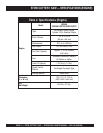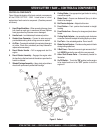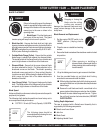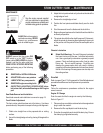
STOW CUTTER 1 SAW — OPERATION & PARTS MANUAL — REV. #6 (06/06/08) — PAGE 15
STOW CUTTER 1 SAW — PREPARATION/PRE-INSPECTION
PREPARATION / PRE-INSPECTION
1. Read and fully understand this manual,
the safety instructions in particular, and
the engine manufacturer's manual
supplied with the saw.
2. Select the correct blade for each application. If abrasive
blades are used, MAKE CERTAIN they are designed for
use on a concrete floor saw. They must be reinforced and
have a hole for the driving pin. When wet cutting with an
abrasive blade, MAKE CERTAIN the blade is intended for
wet cutting. Water will destroy a dry cut abrasive blade.
Some diamond blades require water cooling and failure to
do so will destroy them almost immediately. Other diamond
blades can be used with or without water. Refer to the Blades
and Blade Placement sections on pages 18 and 19 for further
information.
3. Handle all blades with care and NEVER use a damaged
blade. NEVER use an abrasive blade that has been
dropped.
Electric Powered Saws (50 or 60 HZ)
1. The electric motor of this saw requires 230 VAC input
voltage (50/60 Hz, single-phase). Always make certain that
the rated operating line voltage of the motor is correct when
cutting. Electric motors can burn out when the line voltage
falls 10% below the voltage rating of the motor.
2. After the correct input voltage has been applied to the saw,
turn the saw on, and check the rotation of the motor shaft.
The shaft rotation MUST be counter-clockwise when
viewing the motor from the shaft extension end. If the rotation
of the shaft is incorrect make the necessary changes for
the correct shaft rotation.
3. MAKE CERTAIN the correct size extension cord is used.
Undersize extension cords can burn out an electric motor.
Use Table 3 to determine the correct extension cord size.
4.
NEVER!
use a
worn
or
frayed
extension cord.
5. Record the model and serial number of the saw on the
front of the Operating and Parts Manual for future reference.
WARNING
ALWAYS use a grounded (3-wire) extension cord and MAKE
CERTAIN that the motor is connected to a properly grounded
electric circuit to protect the operator from possible electric shock.
Figure 6. Engine Oil Dipstick (Removal)
Gasoline Powered Saws
1. Clean the
saw,
removing dirt and dust, particularly the
engine cooling air inlet, carburetor and air cleaner.
2. Check the air filter for dirt and dust. If air filter is dirty, replace
air filter with a new one as required.
3. Check carburetor for external dirt and dust. Clean with dry
compressed air.
4. Check fastening nuts and bolts for tightness.
Engine Oil Check
1. To check the engine oil level, place the saw on secure level
ground with the engine stopped. The frame platform
must
be level
to accurately check the engine oil.
2. Remove the filler dipstick from the engine oil filler hole
(Figure 6) and wipe it clean.
eziSdroCnoisnetxE.3elbaT
eriW21.oNeriW01.oNeriW8.oNeriW6.oN
)teef(05
)sretem42.51(
)teef(57
sretem68.22(
)teef(001
sretem84.03(
)teef(00
2
sretem69.06(
NEVER!
touch the power cord (Figure 5) with
wet hands
or while
standing in water
when it is connected to a power source. The
possibly exists of electrical shock (electrocution)
even death.
NEVER!
spray water directly on
the electric motor.
POWER
CORD
(POWER ON)
WET
HANDS
Figure 5. Extension Cord (Wet Hands)


















